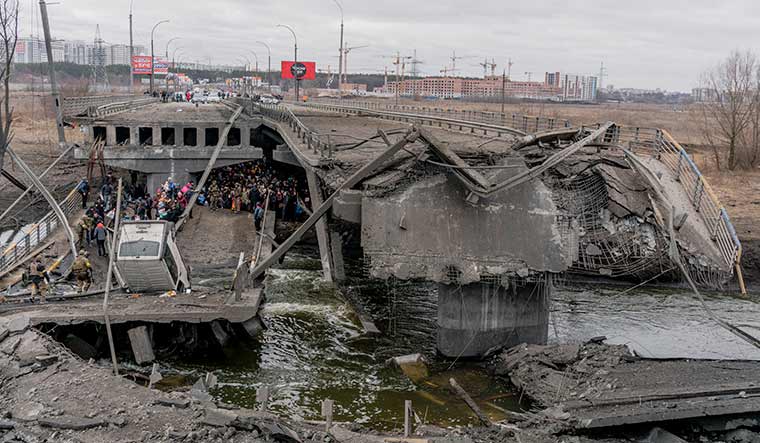Nearly two weeks have passed after Russian President Vladimir Putin ordered his troops into Ukraine. Along with soldiers and civilians, truth, too, has become a major casualty as both sides share diametrically opposite details about their campaigns. As the fight intensifies near Kyiv, in Kharkiv and in the Donbass, Russia acknowledged the loss of about 500 of its personnel and claimed that more than 12,000 Ukrainians were killed. The Ukrainians claim a similar number of Russian deaths.
With Russia stepping up its campaign, the civilian population is dying in huge numbers. The UN has confirmed 474 civilian deaths, while Ukrainian authorities said the number must be many times more. The UN, too, has conceded that the real numbers could be much higher and said a majority of the civilian deaths were caused by heavy artillery shelling, multiple launch rocket systems and air strikes.
The main operations are being conducted in or near large cities, and the humanitarian corridors for the withdrawal of civilians almost do not work. Both sides accuse each other of disrupting agreements to evacuate civilians.
Foreign students, too, have become hostages of the war, forcing countries like India to undertake massive evacuation efforts. The Ukrainian foreign ministry said it helped nearly 1.5 lakh foreign students escape.
Ukrainians, too, are trying to escape from the conflict zone. According to the UN, as of March 7, more than two million people have left the country. Poland seems to be the preferred destination, followed by Hungary, Slovakia, Moldova and Romania.
Several analysts have predicted that if the conflict drags on for another two or three months, the number of refugees could reach 10 million. It would have serious consequences for Europe, which has just begun to recover from the immigration crisis caused by the Syrian and Lebanese wars and the Covid-19 crisis.
President Volodymyr Zelenskyy, who is staying back in Kyiv, has pointed out that the Russian air superiority is turning out to be the biggest challenge for his forces. He asked NATO to impose a no-fly zone and requested for more fighter aircraft. NATO and the US have, however, ruled out closing the Ukrainian airspace as it could lead to a direct conflict with Russia. The US also nixed a Polish proposal to transfer its MiG-29 fleet to Ukraine and in turn receive American F-16s to make up for its loss. Ukraine, however, continues to receive considerable military and monetary support from the west.
Russian ground troops, meanwhile, are closing in on Kyiv. Their main advance is carried out from the north, along both banks of the Dnieper. In addition, Russia is trying to impose a blockade on the capital from the south and the southeast. Despite their valiant fightback, the Ukrainian troops are on the backfoot because of the lack of air support.
“Kyiv continues to fortify and prepare for the defence of the city,” said the city’s mayor, former heavyweight boxing champion Vitali Klitschko. “All critical infrastructure, most grocery stores, hospitals and pharmacies are working.” The mayor assured that the humanitarian support systems, too, are fully functional.
Apart from the defence of its key cities, Ukraine is also worried about the safety of its nuclear installations. Oleg Korikov, who is in charge of the country’s nuclear safety, said the Russian aggression not only risked radiation accidents and loss of control over radiation sources, but also posed unprecedented risks of a global nuclear catastrophe. He said the International Atomic Energy Agency (IAEA) and other international partners are yet to take any action on the issue.
The head of the IAEA, Rafael Grossi, said he was holding consultations to ensure the security of Ukrainian nuclear facilities. He is also considering a visit to Ukraine to discuss further safeguards.
As the war grinds on, Putin has reiterated his conditions for a ceasefire. He wants Ukraine to stop its military campaign, enshrine political neutrality in its constitution, recognise the Russian occupation of Crimea and accept the rebel republics of Donetsk and Luhansk as independent states.
Zelenskyy, meanwhile, stressed on more dialogue and said Ukraine was prepared to seek compromises, but was not ready to capitulate. Interestingly, perhaps for the first time, he publicly announced Ukraine’s readiness to give up its ambition to join NATO. “Regarding NATO, I lost interest after we realised that it is not ready to accept Ukraine. The alliance is afraid of confrontation with Russia,” he said.
Zelenskyy also offered to discuss all contentious issues with Russia. “I think that we can discuss and find a compromise on the points about the temporarily occupied territories and unrecognised republics, which are not recognised by anyone except Russia. We can discuss with Russia about the future of Crimea and Donbass,” said Zelenskyy.
He also mooted a collective security agreement with all of Ukraine’s neighbours, including Russia, and also with the leading states of the world. He said the security guarantees would also apply to Russia, although he said he was not sure who Russia was protecting itself from.
Zelenskyy has intensified contacts with several world leaders, including Prime Minister Narendra Modi. But if it does not work, he said he was going to bypass the leaders and appeal to the people. “I will speak directly to the people if their leaders do not make every effort to stop this war. This is genocide,” he said. “There are things that are not decided in negotiations, which do not depend directly on us, but only on humanity.”


